Organizational Culture Analysis: Dimensions and Characteristics Report
VerifiedAdded on 2021/05/03
|15
|4708
|247
Report
AI Summary
This report delves into the multifaceted dimensions of organizational culture, examining various cultural typologies and their impact on organizational effectiveness. It begins by introducing the Organizational Culture Profile (OCP) framework, which identifies seven distinct values that characterize a company's culture. The report then elaborates on key dimensions such as innovative cultures, emphasizing adaptability and experimentation; outcome-oriented cultures, which prioritize achievement and results; stable cultures, known for their predictability and rule-orientation; people-oriented cultures, valuing fairness and employee well-being; team-oriented cultures, fostering collaboration and cooperation; and detail-oriented cultures, focusing on precision and attention to detail. Furthermore, the report extends beyond the OCP framework to include service culture and safety culture, highlighting their significance in specific industries. The analysis includes real-world examples of companies like W. L. Gore, Best Buy, Starbucks, and Southwest Airlines, illustrating how these dimensions manifest in practice. The report also discusses the potential pitfalls of certain cultural orientations, such as the overemphasis on outcomes that can lead to unethical behaviors. Overall, the report provides a comprehensive overview of organizational culture, its dimensions, and their implications for management and organizational success.
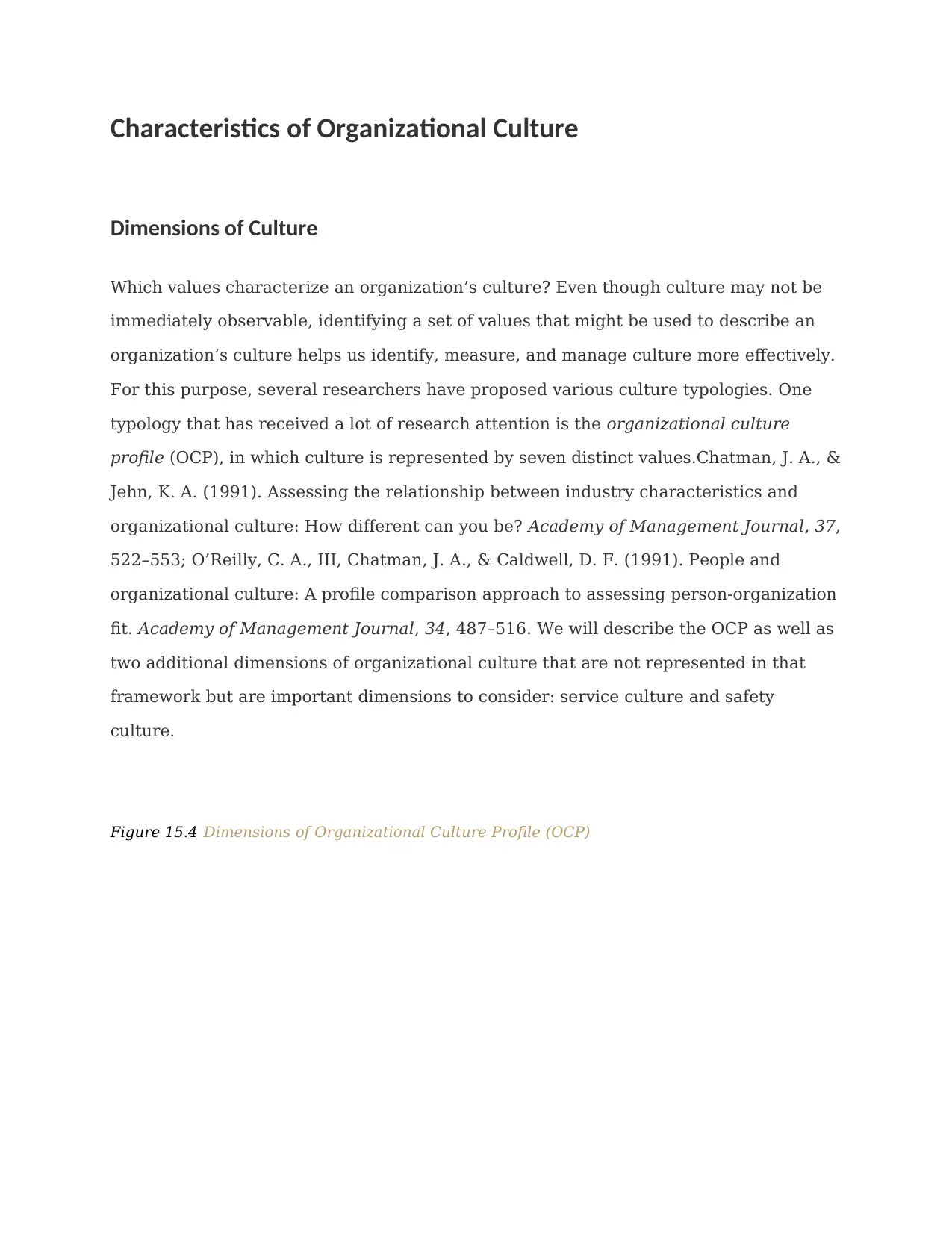
Characteristics of Organizational Culture
Dimensions of Culture
Which values characterize an organization’s culture? Even though culture may not be
immediately observable, identifying a set of values that might be used to describe an
organization’s culture helps us identify, measure, and manage culture more effectively.
For this purpose, several researchers have proposed various culture typologies. One
typology that has received a lot of research attention is the organizational culture
profile (OCP), in which culture is represented by seven distinct values.Chatman, J. A., &
Jehn, K. A. (1991). Assessing the relationship between industry characteristics and
organizational culture: How different can you be? Academy of Management Journal, 37,
522–553; O’Reilly, C. A., III, Chatman, J. A., & Caldwell, D. F. (1991). People and
organizational culture: A profile comparison approach to assessing person-organization
fit. Academy of Management Journal, 34, 487–516. We will describe the OCP as well as
two additional dimensions of organizational culture that are not represented in that
framework but are important dimensions to consider: service culture and safety
culture.
Figure 15.4 Dimensions of Organizational Culture Profile (OCP)
Dimensions of Culture
Which values characterize an organization’s culture? Even though culture may not be
immediately observable, identifying a set of values that might be used to describe an
organization’s culture helps us identify, measure, and manage culture more effectively.
For this purpose, several researchers have proposed various culture typologies. One
typology that has received a lot of research attention is the organizational culture
profile (OCP), in which culture is represented by seven distinct values.Chatman, J. A., &
Jehn, K. A. (1991). Assessing the relationship between industry characteristics and
organizational culture: How different can you be? Academy of Management Journal, 37,
522–553; O’Reilly, C. A., III, Chatman, J. A., & Caldwell, D. F. (1991). People and
organizational culture: A profile comparison approach to assessing person-organization
fit. Academy of Management Journal, 34, 487–516. We will describe the OCP as well as
two additional dimensions of organizational culture that are not represented in that
framework but are important dimensions to consider: service culture and safety
culture.
Figure 15.4 Dimensions of Organizational Culture Profile (OCP)
Secure Best Marks with AI Grader
Need help grading? Try our AI Grader for instant feedback on your assignments.

Source: Adapted from information in O’Reilly, C. A., III, Chatman, J. A., & Caldwell, D. F. (1991).
People and organizational culture: A profile comparison approach to assessing person-
organization fit. Academy of Management Journal, 34, 487–516.
Innovative Cultures
People and organizational culture: A profile comparison approach to assessing person-
organization fit. Academy of Management Journal, 34, 487–516.
Innovative Cultures
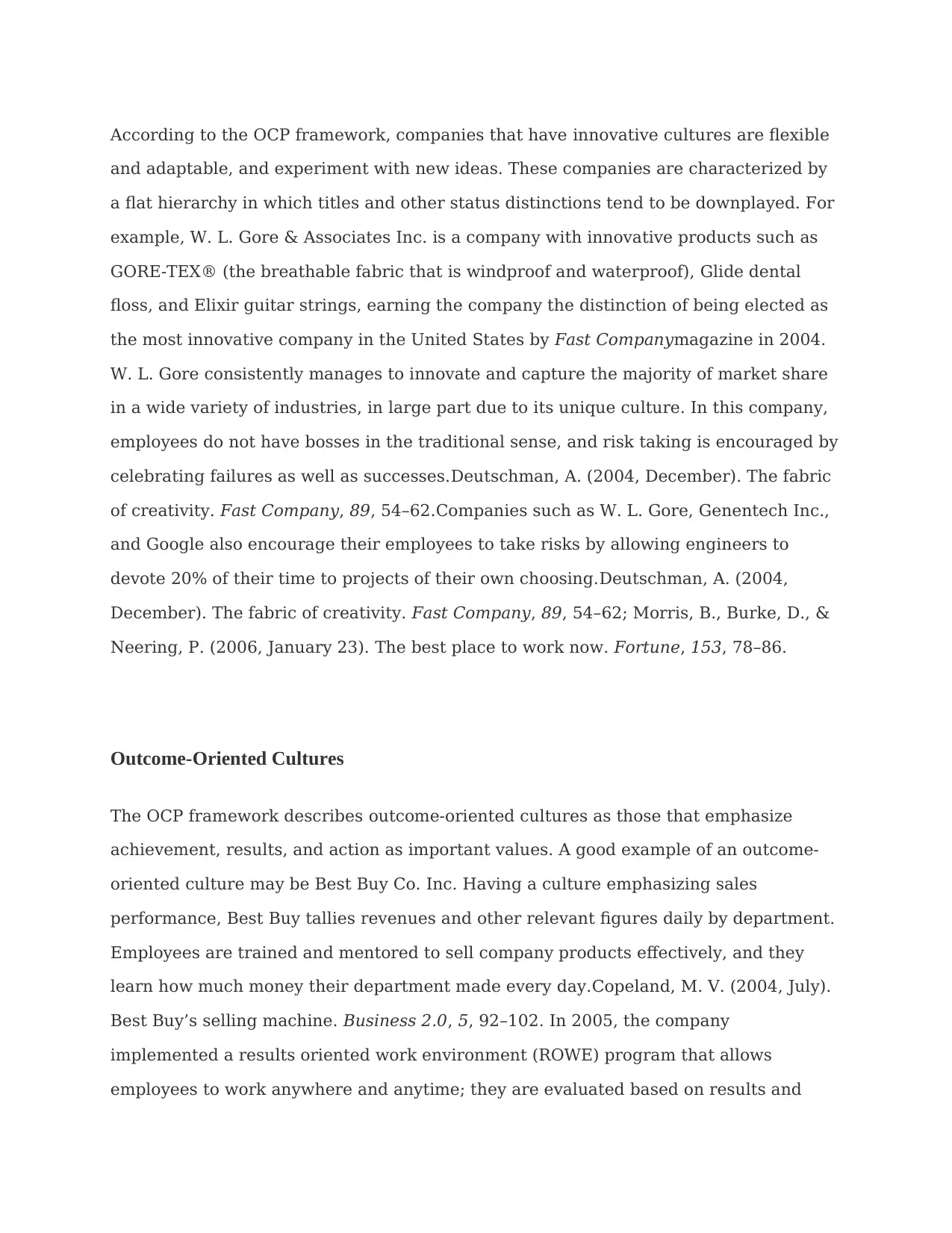
According to the OCP framework, companies that have innovative cultures are flexible
and adaptable, and experiment with new ideas. These companies are characterized by
a flat hierarchy in which titles and other status distinctions tend to be downplayed. For
example, W. L. Gore & Associates Inc. is a company with innovative products such as
GORE-TEX® (the breathable fabric that is windproof and waterproof), Glide dental
floss, and Elixir guitar strings, earning the company the distinction of being elected as
the most innovative company in the United States by Fast Companymagazine in 2004.
W. L. Gore consistently manages to innovate and capture the majority of market share
in a wide variety of industries, in large part due to its unique culture. In this company,
employees do not have bosses in the traditional sense, and risk taking is encouraged by
celebrating failures as well as successes.Deutschman, A. (2004, December). The fabric
of creativity. Fast Company, 89, 54–62.Companies such as W. L. Gore, Genentech Inc.,
and Google also encourage their employees to take risks by allowing engineers to
devote 20% of their time to projects of their own choosing.Deutschman, A. (2004,
December). The fabric of creativity. Fast Company, 89, 54–62; Morris, B., Burke, D., &
Neering, P. (2006, January 23). The best place to work now. Fortune, 153, 78–86.
Outcome-Oriented Cultures
The OCP framework describes outcome-oriented cultures as those that emphasize
achievement, results, and action as important values. A good example of an outcome-
oriented culture may be Best Buy Co. Inc. Having a culture emphasizing sales
performance, Best Buy tallies revenues and other relevant figures daily by department.
Employees are trained and mentored to sell company products effectively, and they
learn how much money their department made every day.Copeland, M. V. (2004, July).
Best Buy’s selling machine. Business 2.0, 5, 92–102. In 2005, the company
implemented a results oriented work environment (ROWE) program that allows
employees to work anywhere and anytime; they are evaluated based on results and
and adaptable, and experiment with new ideas. These companies are characterized by
a flat hierarchy in which titles and other status distinctions tend to be downplayed. For
example, W. L. Gore & Associates Inc. is a company with innovative products such as
GORE-TEX® (the breathable fabric that is windproof and waterproof), Glide dental
floss, and Elixir guitar strings, earning the company the distinction of being elected as
the most innovative company in the United States by Fast Companymagazine in 2004.
W. L. Gore consistently manages to innovate and capture the majority of market share
in a wide variety of industries, in large part due to its unique culture. In this company,
employees do not have bosses in the traditional sense, and risk taking is encouraged by
celebrating failures as well as successes.Deutschman, A. (2004, December). The fabric
of creativity. Fast Company, 89, 54–62.Companies such as W. L. Gore, Genentech Inc.,
and Google also encourage their employees to take risks by allowing engineers to
devote 20% of their time to projects of their own choosing.Deutschman, A. (2004,
December). The fabric of creativity. Fast Company, 89, 54–62; Morris, B., Burke, D., &
Neering, P. (2006, January 23). The best place to work now. Fortune, 153, 78–86.
Outcome-Oriented Cultures
The OCP framework describes outcome-oriented cultures as those that emphasize
achievement, results, and action as important values. A good example of an outcome-
oriented culture may be Best Buy Co. Inc. Having a culture emphasizing sales
performance, Best Buy tallies revenues and other relevant figures daily by department.
Employees are trained and mentored to sell company products effectively, and they
learn how much money their department made every day.Copeland, M. V. (2004, July).
Best Buy’s selling machine. Business 2.0, 5, 92–102. In 2005, the company
implemented a results oriented work environment (ROWE) program that allows
employees to work anywhere and anytime; they are evaluated based on results and
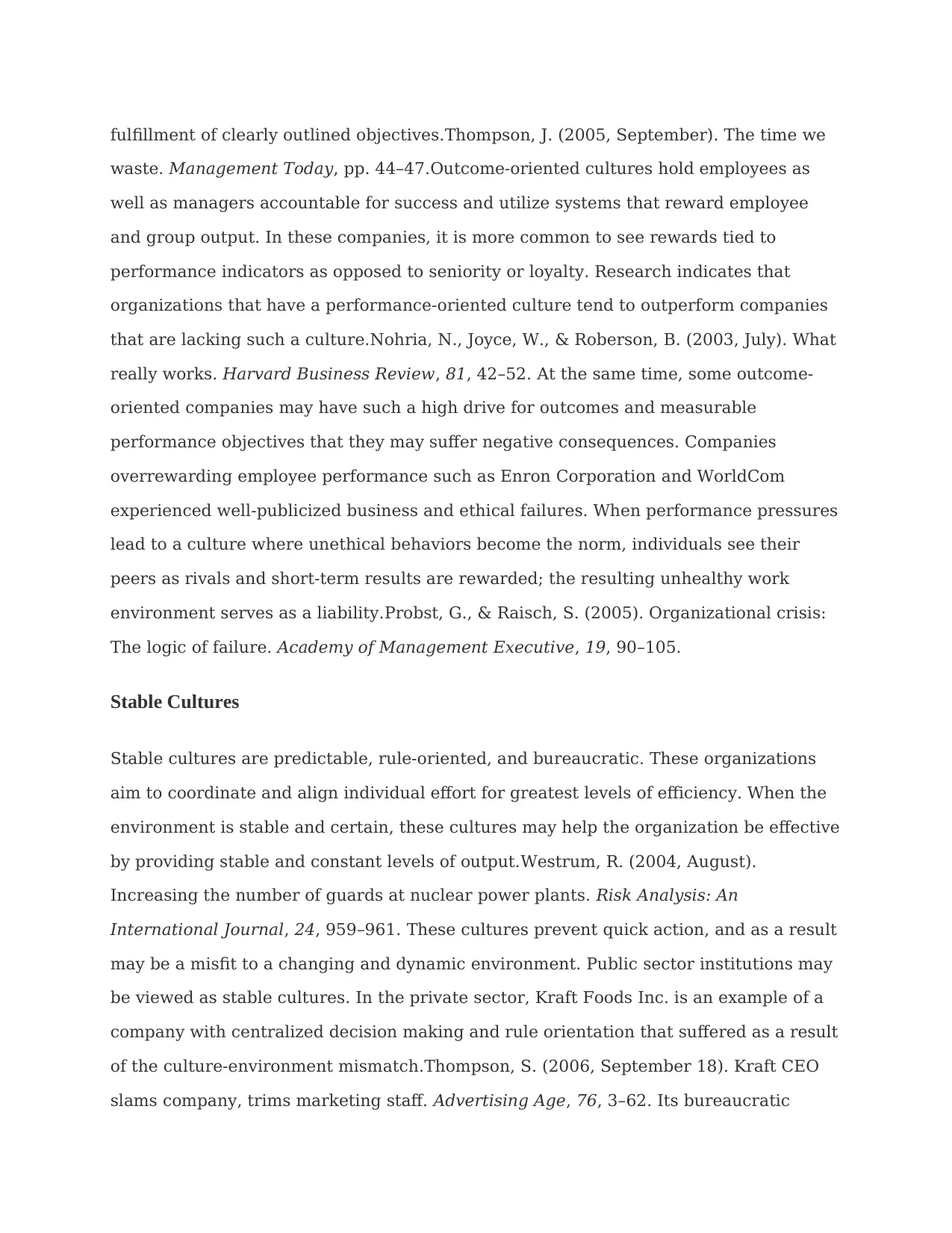
fulfillment of clearly outlined objectives.Thompson, J. (2005, September). The time we
waste. Management Today, pp. 44–47.Outcome-oriented cultures hold employees as
well as managers accountable for success and utilize systems that reward employee
and group output. In these companies, it is more common to see rewards tied to
performance indicators as opposed to seniority or loyalty. Research indicates that
organizations that have a performance-oriented culture tend to outperform companies
that are lacking such a culture.Nohria, N., Joyce, W., & Roberson, B. (2003, July). What
really works. Harvard Business Review, 81, 42–52. At the same time, some outcome-
oriented companies may have such a high drive for outcomes and measurable
performance objectives that they may suffer negative consequences. Companies
overrewarding employee performance such as Enron Corporation and WorldCom
experienced well-publicized business and ethical failures. When performance pressures
lead to a culture where unethical behaviors become the norm, individuals see their
peers as rivals and short-term results are rewarded; the resulting unhealthy work
environment serves as a liability.Probst, G., & Raisch, S. (2005). Organizational crisis:
The logic of failure. Academy of Management Executive, 19, 90–105.
Stable Cultures
Stable cultures are predictable, rule-oriented, and bureaucratic. These organizations
aim to coordinate and align individual effort for greatest levels of efficiency. When the
environment is stable and certain, these cultures may help the organization be effective
by providing stable and constant levels of output.Westrum, R. (2004, August).
Increasing the number of guards at nuclear power plants. Risk Analysis: An
International Journal, 24, 959–961. These cultures prevent quick action, and as a result
may be a misfit to a changing and dynamic environment. Public sector institutions may
be viewed as stable cultures. In the private sector, Kraft Foods Inc. is an example of a
company with centralized decision making and rule orientation that suffered as a result
of the culture-environment mismatch.Thompson, S. (2006, September 18). Kraft CEO
slams company, trims marketing staff. Advertising Age, 76, 3–62. Its bureaucratic
waste. Management Today, pp. 44–47.Outcome-oriented cultures hold employees as
well as managers accountable for success and utilize systems that reward employee
and group output. In these companies, it is more common to see rewards tied to
performance indicators as opposed to seniority or loyalty. Research indicates that
organizations that have a performance-oriented culture tend to outperform companies
that are lacking such a culture.Nohria, N., Joyce, W., & Roberson, B. (2003, July). What
really works. Harvard Business Review, 81, 42–52. At the same time, some outcome-
oriented companies may have such a high drive for outcomes and measurable
performance objectives that they may suffer negative consequences. Companies
overrewarding employee performance such as Enron Corporation and WorldCom
experienced well-publicized business and ethical failures. When performance pressures
lead to a culture where unethical behaviors become the norm, individuals see their
peers as rivals and short-term results are rewarded; the resulting unhealthy work
environment serves as a liability.Probst, G., & Raisch, S. (2005). Organizational crisis:
The logic of failure. Academy of Management Executive, 19, 90–105.
Stable Cultures
Stable cultures are predictable, rule-oriented, and bureaucratic. These organizations
aim to coordinate and align individual effort for greatest levels of efficiency. When the
environment is stable and certain, these cultures may help the organization be effective
by providing stable and constant levels of output.Westrum, R. (2004, August).
Increasing the number of guards at nuclear power plants. Risk Analysis: An
International Journal, 24, 959–961. These cultures prevent quick action, and as a result
may be a misfit to a changing and dynamic environment. Public sector institutions may
be viewed as stable cultures. In the private sector, Kraft Foods Inc. is an example of a
company with centralized decision making and rule orientation that suffered as a result
of the culture-environment mismatch.Thompson, S. (2006, September 18). Kraft CEO
slams company, trims marketing staff. Advertising Age, 76, 3–62. Its bureaucratic
Secure Best Marks with AI Grader
Need help grading? Try our AI Grader for instant feedback on your assignments.
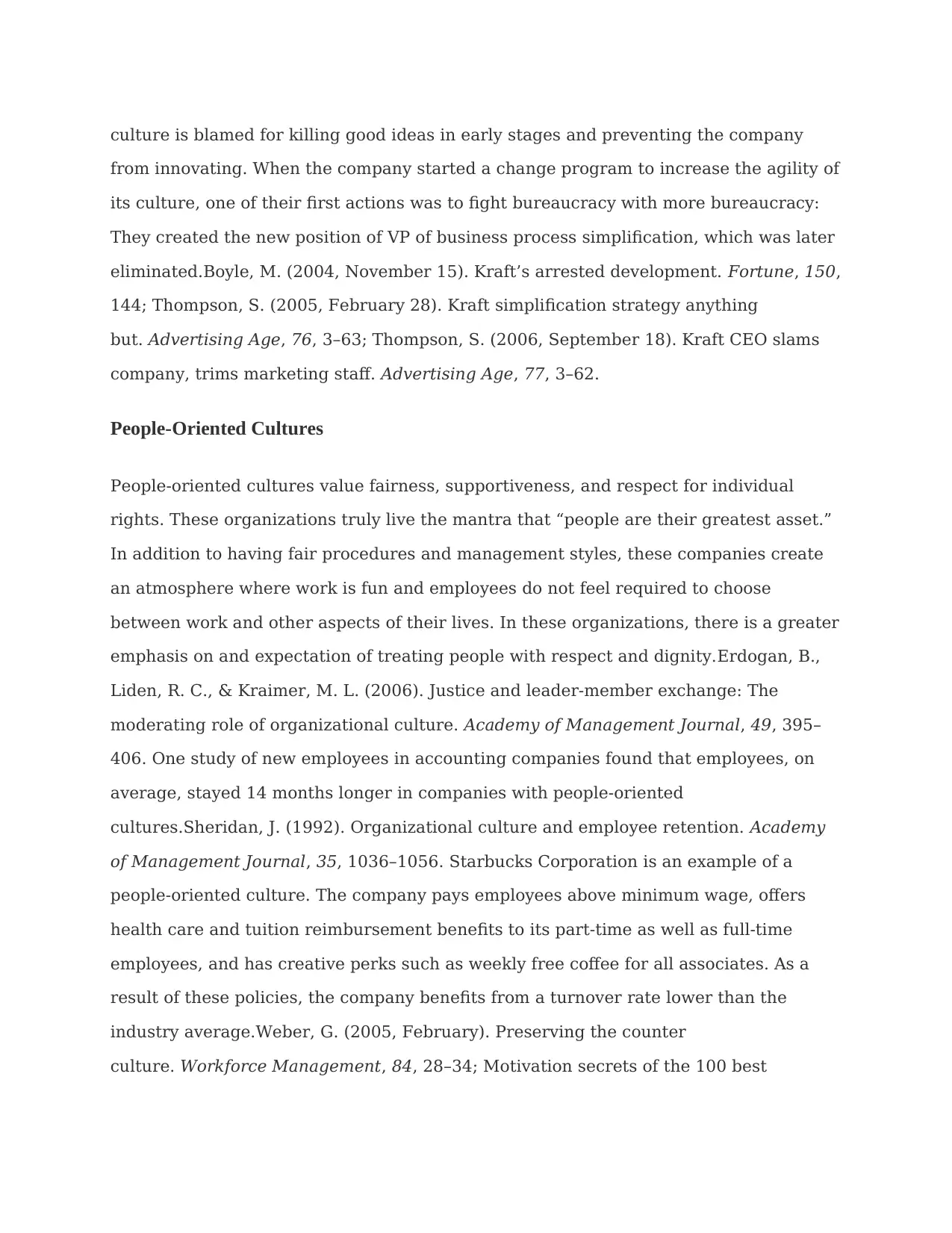
culture is blamed for killing good ideas in early stages and preventing the company
from innovating. When the company started a change program to increase the agility of
its culture, one of their first actions was to fight bureaucracy with more bureaucracy:
They created the new position of VP of business process simplification, which was later
eliminated.Boyle, M. (2004, November 15). Kraft’s arrested development. Fortune, 150,
144; Thompson, S. (2005, February 28). Kraft simplification strategy anything
but. Advertising Age, 76, 3–63; Thompson, S. (2006, September 18). Kraft CEO slams
company, trims marketing staff. Advertising Age, 77, 3–62.
People-Oriented Cultures
People-oriented cultures value fairness, supportiveness, and respect for individual
rights. These organizations truly live the mantra that “people are their greatest asset.”
In addition to having fair procedures and management styles, these companies create
an atmosphere where work is fun and employees do not feel required to choose
between work and other aspects of their lives. In these organizations, there is a greater
emphasis on and expectation of treating people with respect and dignity.Erdogan, B.,
Liden, R. C., & Kraimer, M. L. (2006). Justice and leader-member exchange: The
moderating role of organizational culture. Academy of Management Journal, 49, 395–
406. One study of new employees in accounting companies found that employees, on
average, stayed 14 months longer in companies with people-oriented
cultures.Sheridan, J. (1992). Organizational culture and employee retention. Academy
of Management Journal, 35, 1036–1056. Starbucks Corporation is an example of a
people-oriented culture. The company pays employees above minimum wage, offers
health care and tuition reimbursement benefits to its part-time as well as full-time
employees, and has creative perks such as weekly free coffee for all associates. As a
result of these policies, the company benefits from a turnover rate lower than the
industry average.Weber, G. (2005, February). Preserving the counter
culture. Workforce Management, 84, 28–34; Motivation secrets of the 100 best
from innovating. When the company started a change program to increase the agility of
its culture, one of their first actions was to fight bureaucracy with more bureaucracy:
They created the new position of VP of business process simplification, which was later
eliminated.Boyle, M. (2004, November 15). Kraft’s arrested development. Fortune, 150,
144; Thompson, S. (2005, February 28). Kraft simplification strategy anything
but. Advertising Age, 76, 3–63; Thompson, S. (2006, September 18). Kraft CEO slams
company, trims marketing staff. Advertising Age, 77, 3–62.
People-Oriented Cultures
People-oriented cultures value fairness, supportiveness, and respect for individual
rights. These organizations truly live the mantra that “people are their greatest asset.”
In addition to having fair procedures and management styles, these companies create
an atmosphere where work is fun and employees do not feel required to choose
between work and other aspects of their lives. In these organizations, there is a greater
emphasis on and expectation of treating people with respect and dignity.Erdogan, B.,
Liden, R. C., & Kraimer, M. L. (2006). Justice and leader-member exchange: The
moderating role of organizational culture. Academy of Management Journal, 49, 395–
406. One study of new employees in accounting companies found that employees, on
average, stayed 14 months longer in companies with people-oriented
cultures.Sheridan, J. (1992). Organizational culture and employee retention. Academy
of Management Journal, 35, 1036–1056. Starbucks Corporation is an example of a
people-oriented culture. The company pays employees above minimum wage, offers
health care and tuition reimbursement benefits to its part-time as well as full-time
employees, and has creative perks such as weekly free coffee for all associates. As a
result of these policies, the company benefits from a turnover rate lower than the
industry average.Weber, G. (2005, February). Preserving the counter
culture. Workforce Management, 84, 28–34; Motivation secrets of the 100 best
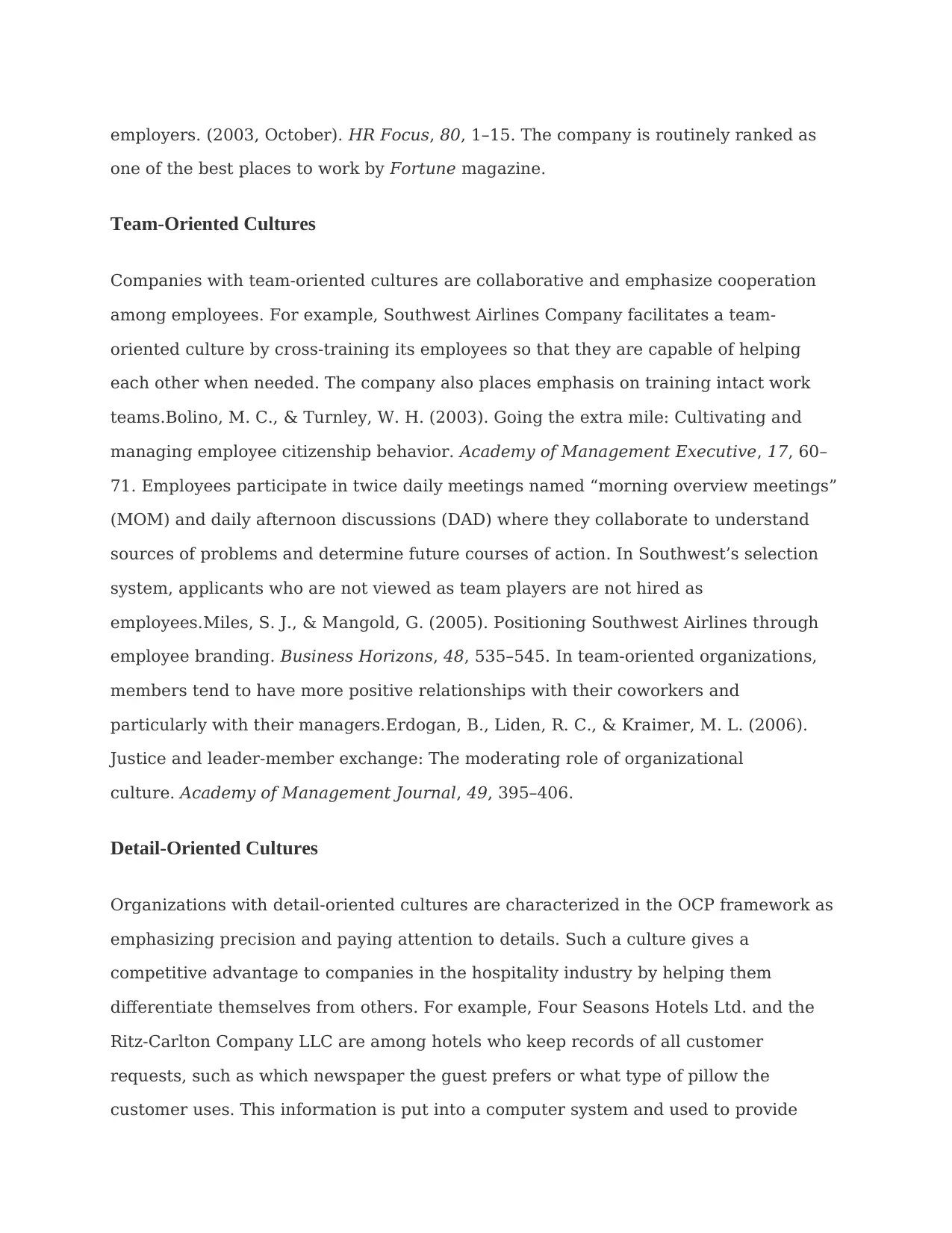
employers. (2003, October). HR Focus, 80, 1–15. The company is routinely ranked as
one of the best places to work by Fortune magazine.
Team-Oriented Cultures
Companies with team-oriented cultures are collaborative and emphasize cooperation
among employees. For example, Southwest Airlines Company facilitates a team-
oriented culture by cross-training its employees so that they are capable of helping
each other when needed. The company also places emphasis on training intact work
teams.Bolino, M. C., & Turnley, W. H. (2003). Going the extra mile: Cultivating and
managing employee citizenship behavior. Academy of Management Executive, 17, 60–
71. Employees participate in twice daily meetings named “morning overview meetings”
(MOM) and daily afternoon discussions (DAD) where they collaborate to understand
sources of problems and determine future courses of action. In Southwest’s selection
system, applicants who are not viewed as team players are not hired as
employees.Miles, S. J., & Mangold, G. (2005). Positioning Southwest Airlines through
employee branding. Business Horizons, 48, 535–545. In team-oriented organizations,
members tend to have more positive relationships with their coworkers and
particularly with their managers.Erdogan, B., Liden, R. C., & Kraimer, M. L. (2006).
Justice and leader-member exchange: The moderating role of organizational
culture. Academy of Management Journal, 49, 395–406.
Detail-Oriented Cultures
Organizations with detail-oriented cultures are characterized in the OCP framework as
emphasizing precision and paying attention to details. Such a culture gives a
competitive advantage to companies in the hospitality industry by helping them
differentiate themselves from others. For example, Four Seasons Hotels Ltd. and the
Ritz-Carlton Company LLC are among hotels who keep records of all customer
requests, such as which newspaper the guest prefers or what type of pillow the
customer uses. This information is put into a computer system and used to provide
one of the best places to work by Fortune magazine.
Team-Oriented Cultures
Companies with team-oriented cultures are collaborative and emphasize cooperation
among employees. For example, Southwest Airlines Company facilitates a team-
oriented culture by cross-training its employees so that they are capable of helping
each other when needed. The company also places emphasis on training intact work
teams.Bolino, M. C., & Turnley, W. H. (2003). Going the extra mile: Cultivating and
managing employee citizenship behavior. Academy of Management Executive, 17, 60–
71. Employees participate in twice daily meetings named “morning overview meetings”
(MOM) and daily afternoon discussions (DAD) where they collaborate to understand
sources of problems and determine future courses of action. In Southwest’s selection
system, applicants who are not viewed as team players are not hired as
employees.Miles, S. J., & Mangold, G. (2005). Positioning Southwest Airlines through
employee branding. Business Horizons, 48, 535–545. In team-oriented organizations,
members tend to have more positive relationships with their coworkers and
particularly with their managers.Erdogan, B., Liden, R. C., & Kraimer, M. L. (2006).
Justice and leader-member exchange: The moderating role of organizational
culture. Academy of Management Journal, 49, 395–406.
Detail-Oriented Cultures
Organizations with detail-oriented cultures are characterized in the OCP framework as
emphasizing precision and paying attention to details. Such a culture gives a
competitive advantage to companies in the hospitality industry by helping them
differentiate themselves from others. For example, Four Seasons Hotels Ltd. and the
Ritz-Carlton Company LLC are among hotels who keep records of all customer
requests, such as which newspaper the guest prefers or what type of pillow the
customer uses. This information is put into a computer system and used to provide

better service to returning customers. Any requests hotel employees receive, as well as
overhear, might be entered into the database to serve customers better. Recent guests
to Four Seasons Paris who were celebrating their 21st anniversary were greeted with a
bouquet of 21 roses on their bed. Such clear attention to detail is an effective way of
impressing customers and ensuring repeat visits. McDonald’s Corporation is another
company that specifies in detail how employees should perform their jobs by including
photos of exactly how French fries and hamburgers should look when prepared
properly.Fitch, S. (2004, May 10). Soft pillows and sharp elbows. Forbes, 173, 66–78;
ford, R. C., & Heaton, C. P. (2001). Lessons from hospitality that can serve
anyone. Organizational Dynamics, 30, 30–47; Kolesnikov-Jessop, S. (2005, November).
Four Seasons Singapore: Tops in Asia. Institutional Investor, 39, 103–104; Markels, A.
(2007, April 23). Dishing it out in style. U.S. News & World Report, 142, 52–55.
Service Culture
Service culture is not one of the dimensions of OCP, but given the importance of the
retail industry in the overall economy, having a service culture can make or break an
organization. Some of the organizations we have illustrated in this section, such as
Nordstrom, Southwest Airlines, Ritz-Carlton, and Four Seasons are also famous for
their service culture. In these organizations, employees are trained to serve the
customer well, and cross-training is the norm. Employees are empowered to resolve
customer problems in ways they see fit. Because employees with direct customer
contact are in the best position to resolve any issues, employee empowerment is truly
valued in these companies. For example, Umpqua Bank, operating in the northwestern
United States, is known for its service culture. All employees are trained in all tasks to
enable any employee to help customers when needed. Branch employees may come up
with unique ways in which they serve customers better, such as opening their lobby for
community events or keeping bowls full of water for customers’ pets. The branches
feature coffee for customers, Internet kiosks, and withdrawn funds are given on a tray
along with a piece of chocolate. They also reward employee service performance
overhear, might be entered into the database to serve customers better. Recent guests
to Four Seasons Paris who were celebrating their 21st anniversary were greeted with a
bouquet of 21 roses on their bed. Such clear attention to detail is an effective way of
impressing customers and ensuring repeat visits. McDonald’s Corporation is another
company that specifies in detail how employees should perform their jobs by including
photos of exactly how French fries and hamburgers should look when prepared
properly.Fitch, S. (2004, May 10). Soft pillows and sharp elbows. Forbes, 173, 66–78;
ford, R. C., & Heaton, C. P. (2001). Lessons from hospitality that can serve
anyone. Organizational Dynamics, 30, 30–47; Kolesnikov-Jessop, S. (2005, November).
Four Seasons Singapore: Tops in Asia. Institutional Investor, 39, 103–104; Markels, A.
(2007, April 23). Dishing it out in style. U.S. News & World Report, 142, 52–55.
Service Culture
Service culture is not one of the dimensions of OCP, but given the importance of the
retail industry in the overall economy, having a service culture can make or break an
organization. Some of the organizations we have illustrated in this section, such as
Nordstrom, Southwest Airlines, Ritz-Carlton, and Four Seasons are also famous for
their service culture. In these organizations, employees are trained to serve the
customer well, and cross-training is the norm. Employees are empowered to resolve
customer problems in ways they see fit. Because employees with direct customer
contact are in the best position to resolve any issues, employee empowerment is truly
valued in these companies. For example, Umpqua Bank, operating in the northwestern
United States, is known for its service culture. All employees are trained in all tasks to
enable any employee to help customers when needed. Branch employees may come up
with unique ways in which they serve customers better, such as opening their lobby for
community events or keeping bowls full of water for customers’ pets. The branches
feature coffee for customers, Internet kiosks, and withdrawn funds are given on a tray
along with a piece of chocolate. They also reward employee service performance
Paraphrase This Document
Need a fresh take? Get an instant paraphrase of this document with our AI Paraphraser
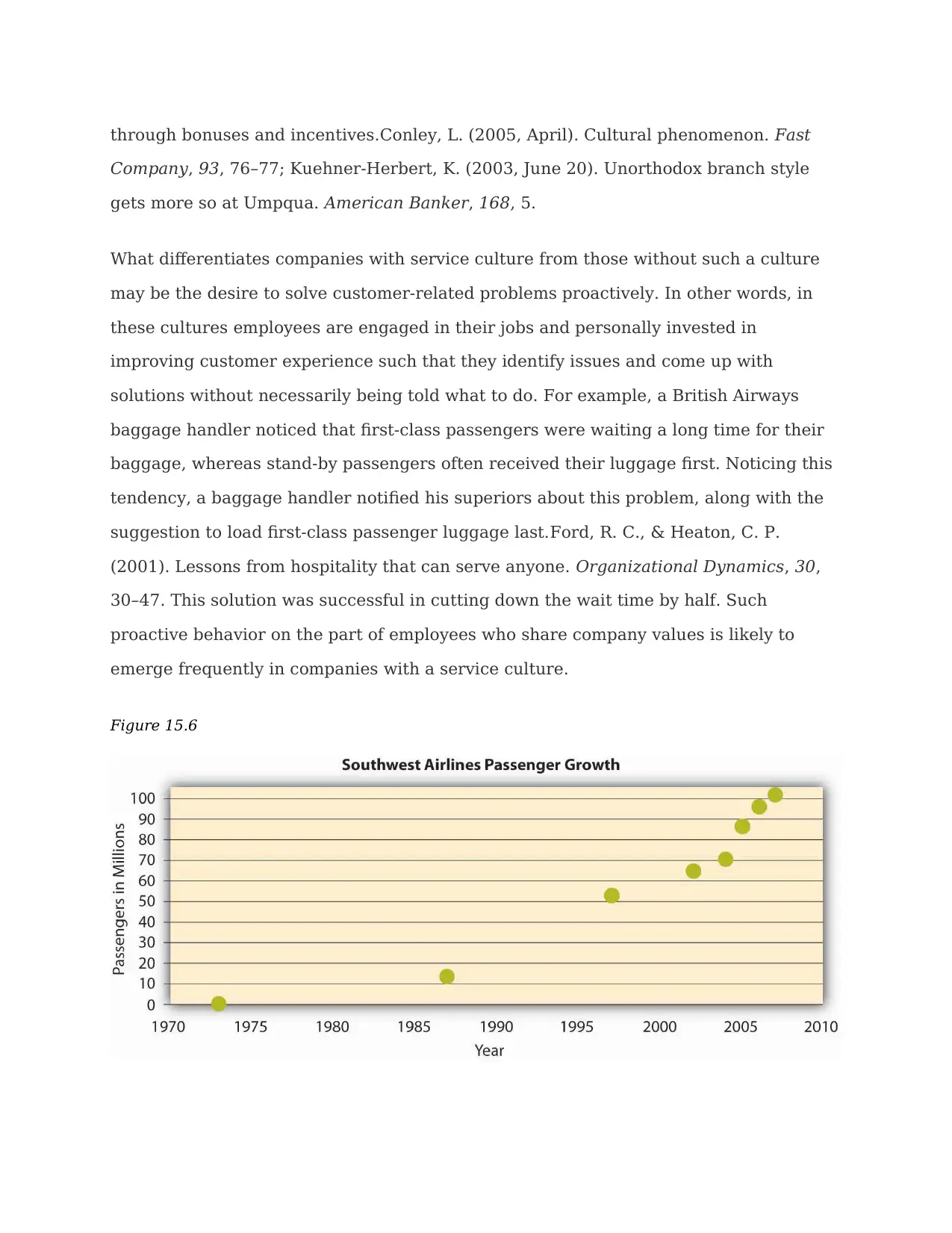
through bonuses and incentives.Conley, L. (2005, April). Cultural phenomenon. Fast
Company, 93, 76–77; Kuehner-Herbert, K. (2003, June 20). Unorthodox branch style
gets more so at Umpqua. American Banker, 168, 5.
What differentiates companies with service culture from those without such a culture
may be the desire to solve customer-related problems proactively. In other words, in
these cultures employees are engaged in their jobs and personally invested in
improving customer experience such that they identify issues and come up with
solutions without necessarily being told what to do. For example, a British Airways
baggage handler noticed that first-class passengers were waiting a long time for their
baggage, whereas stand-by passengers often received their luggage first. Noticing this
tendency, a baggage handler notified his superiors about this problem, along with the
suggestion to load first-class passenger luggage last.Ford, R. C., & Heaton, C. P.
(2001). Lessons from hospitality that can serve anyone. Organizational Dynamics, 30,
30–47. This solution was successful in cutting down the wait time by half. Such
proactive behavior on the part of employees who share company values is likely to
emerge frequently in companies with a service culture.
Figure 15.6
Company, 93, 76–77; Kuehner-Herbert, K. (2003, June 20). Unorthodox branch style
gets more so at Umpqua. American Banker, 168, 5.
What differentiates companies with service culture from those without such a culture
may be the desire to solve customer-related problems proactively. In other words, in
these cultures employees are engaged in their jobs and personally invested in
improving customer experience such that they identify issues and come up with
solutions without necessarily being told what to do. For example, a British Airways
baggage handler noticed that first-class passengers were waiting a long time for their
baggage, whereas stand-by passengers often received their luggage first. Noticing this
tendency, a baggage handler notified his superiors about this problem, along with the
suggestion to load first-class passenger luggage last.Ford, R. C., & Heaton, C. P.
(2001). Lessons from hospitality that can serve anyone. Organizational Dynamics, 30,
30–47. This solution was successful in cutting down the wait time by half. Such
proactive behavior on the part of employees who share company values is likely to
emerge frequently in companies with a service culture.
Figure 15.6
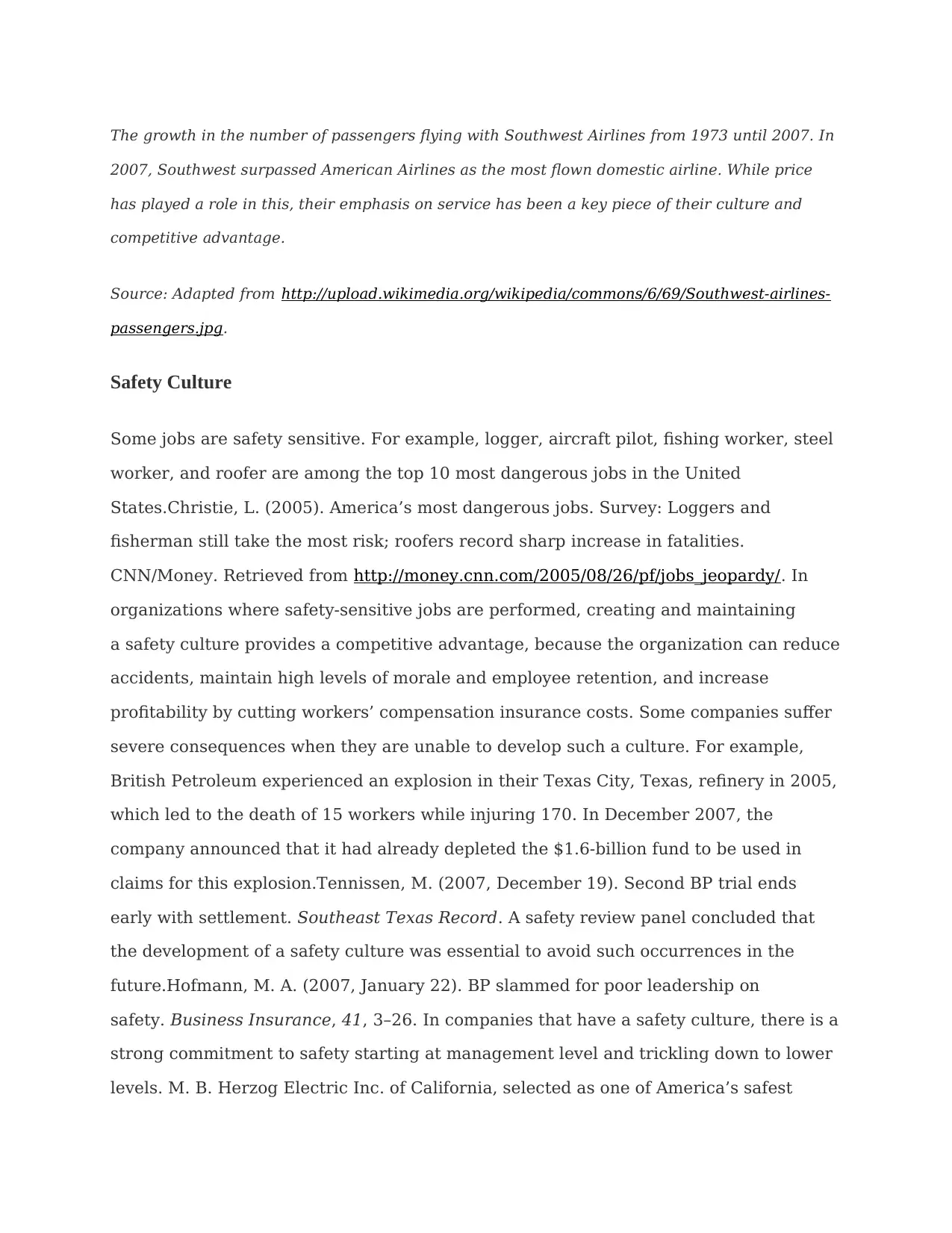
The growth in the number of passengers flying with Southwest Airlines from 1973 until 2007. In
2007, Southwest surpassed American Airlines as the most flown domestic airline. While price
has played a role in this, their emphasis on service has been a key piece of their culture and
competitive advantage.
Source: Adapted from http://upload.wikimedia.org/wikipedia/commons/6/69/Southwest-airlines-
passengers.jpg.
Safety Culture
Some jobs are safety sensitive. For example, logger, aircraft pilot, fishing worker, steel
worker, and roofer are among the top 10 most dangerous jobs in the United
States.Christie, L. (2005). America’s most dangerous jobs. Survey: Loggers and
fisherman still take the most risk; roofers record sharp increase in fatalities.
CNN/Money. Retrieved from http://money.cnn.com/2005/08/26/pf/jobs_jeopardy/. In
organizations where safety-sensitive jobs are performed, creating and maintaining
a safety culture provides a competitive advantage, because the organization can reduce
accidents, maintain high levels of morale and employee retention, and increase
profitability by cutting workers’ compensation insurance costs. Some companies suffer
severe consequences when they are unable to develop such a culture. For example,
British Petroleum experienced an explosion in their Texas City, Texas, refinery in 2005,
which led to the death of 15 workers while injuring 170. In December 2007, the
company announced that it had already depleted the $1.6-billion fund to be used in
claims for this explosion.Tennissen, M. (2007, December 19). Second BP trial ends
early with settlement. Southeast Texas Record. A safety review panel concluded that
the development of a safety culture was essential to avoid such occurrences in the
future.Hofmann, M. A. (2007, January 22). BP slammed for poor leadership on
safety. Business Insurance, 41, 3–26. In companies that have a safety culture, there is a
strong commitment to safety starting at management level and trickling down to lower
levels. M. B. Herzog Electric Inc. of California, selected as one of America’s safest
2007, Southwest surpassed American Airlines as the most flown domestic airline. While price
has played a role in this, their emphasis on service has been a key piece of their culture and
competitive advantage.
Source: Adapted from http://upload.wikimedia.org/wikipedia/commons/6/69/Southwest-airlines-
passengers.jpg.
Safety Culture
Some jobs are safety sensitive. For example, logger, aircraft pilot, fishing worker, steel
worker, and roofer are among the top 10 most dangerous jobs in the United
States.Christie, L. (2005). America’s most dangerous jobs. Survey: Loggers and
fisherman still take the most risk; roofers record sharp increase in fatalities.
CNN/Money. Retrieved from http://money.cnn.com/2005/08/26/pf/jobs_jeopardy/. In
organizations where safety-sensitive jobs are performed, creating and maintaining
a safety culture provides a competitive advantage, because the organization can reduce
accidents, maintain high levels of morale and employee retention, and increase
profitability by cutting workers’ compensation insurance costs. Some companies suffer
severe consequences when they are unable to develop such a culture. For example,
British Petroleum experienced an explosion in their Texas City, Texas, refinery in 2005,
which led to the death of 15 workers while injuring 170. In December 2007, the
company announced that it had already depleted the $1.6-billion fund to be used in
claims for this explosion.Tennissen, M. (2007, December 19). Second BP trial ends
early with settlement. Southeast Texas Record. A safety review panel concluded that
the development of a safety culture was essential to avoid such occurrences in the
future.Hofmann, M. A. (2007, January 22). BP slammed for poor leadership on
safety. Business Insurance, 41, 3–26. In companies that have a safety culture, there is a
strong commitment to safety starting at management level and trickling down to lower
levels. M. B. Herzog Electric Inc. of California, selected as one of America’s safest
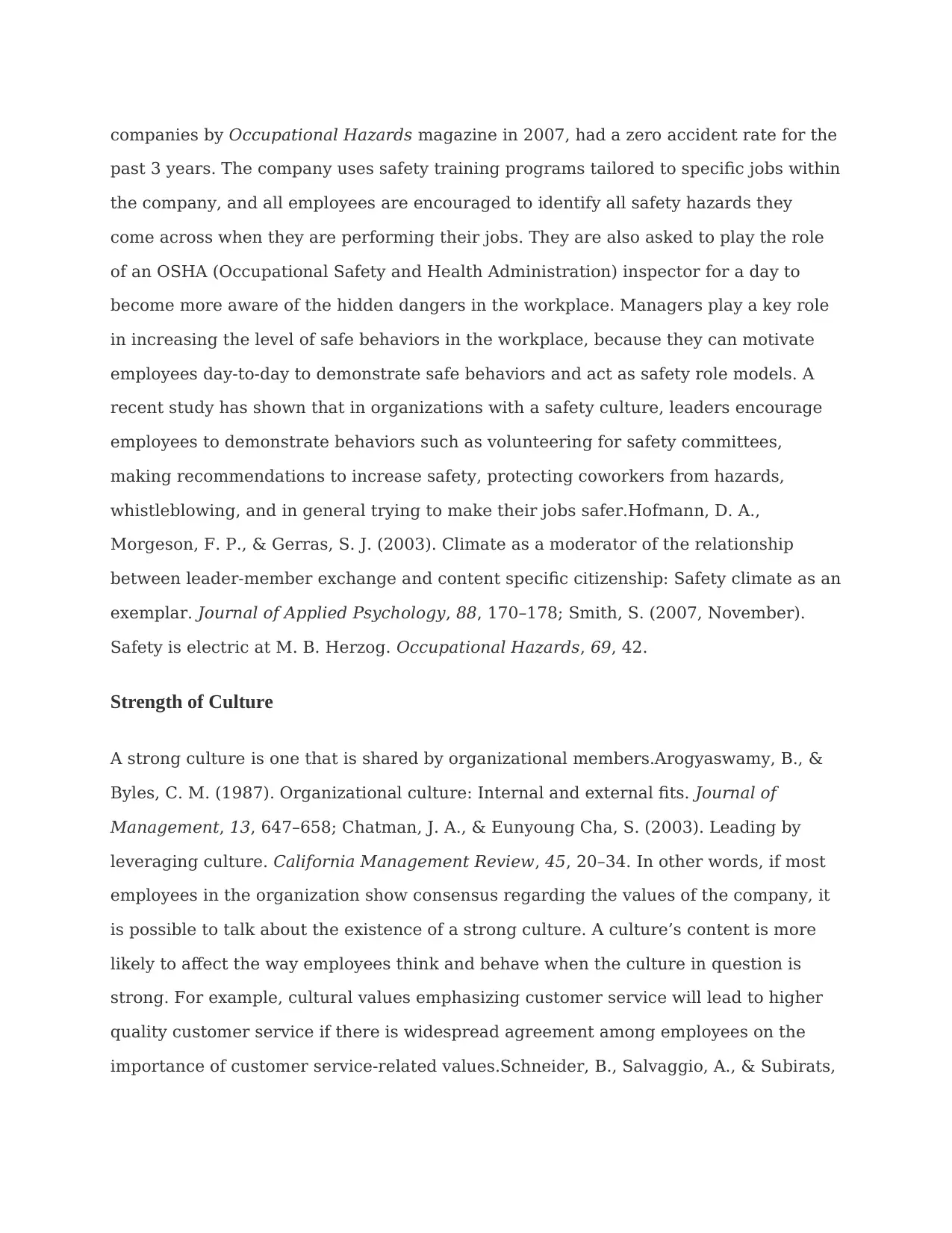
companies by Occupational Hazards magazine in 2007, had a zero accident rate for the
past 3 years. The company uses safety training programs tailored to specific jobs within
the company, and all employees are encouraged to identify all safety hazards they
come across when they are performing their jobs. They are also asked to play the role
of an OSHA (Occupational Safety and Health Administration) inspector for a day to
become more aware of the hidden dangers in the workplace. Managers play a key role
in increasing the level of safe behaviors in the workplace, because they can motivate
employees day-to-day to demonstrate safe behaviors and act as safety role models. A
recent study has shown that in organizations with a safety culture, leaders encourage
employees to demonstrate behaviors such as volunteering for safety committees,
making recommendations to increase safety, protecting coworkers from hazards,
whistleblowing, and in general trying to make their jobs safer.Hofmann, D. A.,
Morgeson, F. P., & Gerras, S. J. (2003). Climate as a moderator of the relationship
between leader-member exchange and content specific citizenship: Safety climate as an
exemplar. Journal of Applied Psychology, 88, 170–178; Smith, S. (2007, November).
Safety is electric at M. B. Herzog. Occupational Hazards, 69, 42.
Strength of Culture
A strong culture is one that is shared by organizational members.Arogyaswamy, B., &
Byles, C. M. (1987). Organizational culture: Internal and external fits. Journal of
Management, 13, 647–658; Chatman, J. A., & Eunyoung Cha, S. (2003). Leading by
leveraging culture. California Management Review, 45, 20–34. In other words, if most
employees in the organization show consensus regarding the values of the company, it
is possible to talk about the existence of a strong culture. A culture’s content is more
likely to affect the way employees think and behave when the culture in question is
strong. For example, cultural values emphasizing customer service will lead to higher
quality customer service if there is widespread agreement among employees on the
importance of customer service-related values.Schneider, B., Salvaggio, A., & Subirats,
past 3 years. The company uses safety training programs tailored to specific jobs within
the company, and all employees are encouraged to identify all safety hazards they
come across when they are performing their jobs. They are also asked to play the role
of an OSHA (Occupational Safety and Health Administration) inspector for a day to
become more aware of the hidden dangers in the workplace. Managers play a key role
in increasing the level of safe behaviors in the workplace, because they can motivate
employees day-to-day to demonstrate safe behaviors and act as safety role models. A
recent study has shown that in organizations with a safety culture, leaders encourage
employees to demonstrate behaviors such as volunteering for safety committees,
making recommendations to increase safety, protecting coworkers from hazards,
whistleblowing, and in general trying to make their jobs safer.Hofmann, D. A.,
Morgeson, F. P., & Gerras, S. J. (2003). Climate as a moderator of the relationship
between leader-member exchange and content specific citizenship: Safety climate as an
exemplar. Journal of Applied Psychology, 88, 170–178; Smith, S. (2007, November).
Safety is electric at M. B. Herzog. Occupational Hazards, 69, 42.
Strength of Culture
A strong culture is one that is shared by organizational members.Arogyaswamy, B., &
Byles, C. M. (1987). Organizational culture: Internal and external fits. Journal of
Management, 13, 647–658; Chatman, J. A., & Eunyoung Cha, S. (2003). Leading by
leveraging culture. California Management Review, 45, 20–34. In other words, if most
employees in the organization show consensus regarding the values of the company, it
is possible to talk about the existence of a strong culture. A culture’s content is more
likely to affect the way employees think and behave when the culture in question is
strong. For example, cultural values emphasizing customer service will lead to higher
quality customer service if there is widespread agreement among employees on the
importance of customer service-related values.Schneider, B., Salvaggio, A., & Subirats,
Secure Best Marks with AI Grader
Need help grading? Try our AI Grader for instant feedback on your assignments.
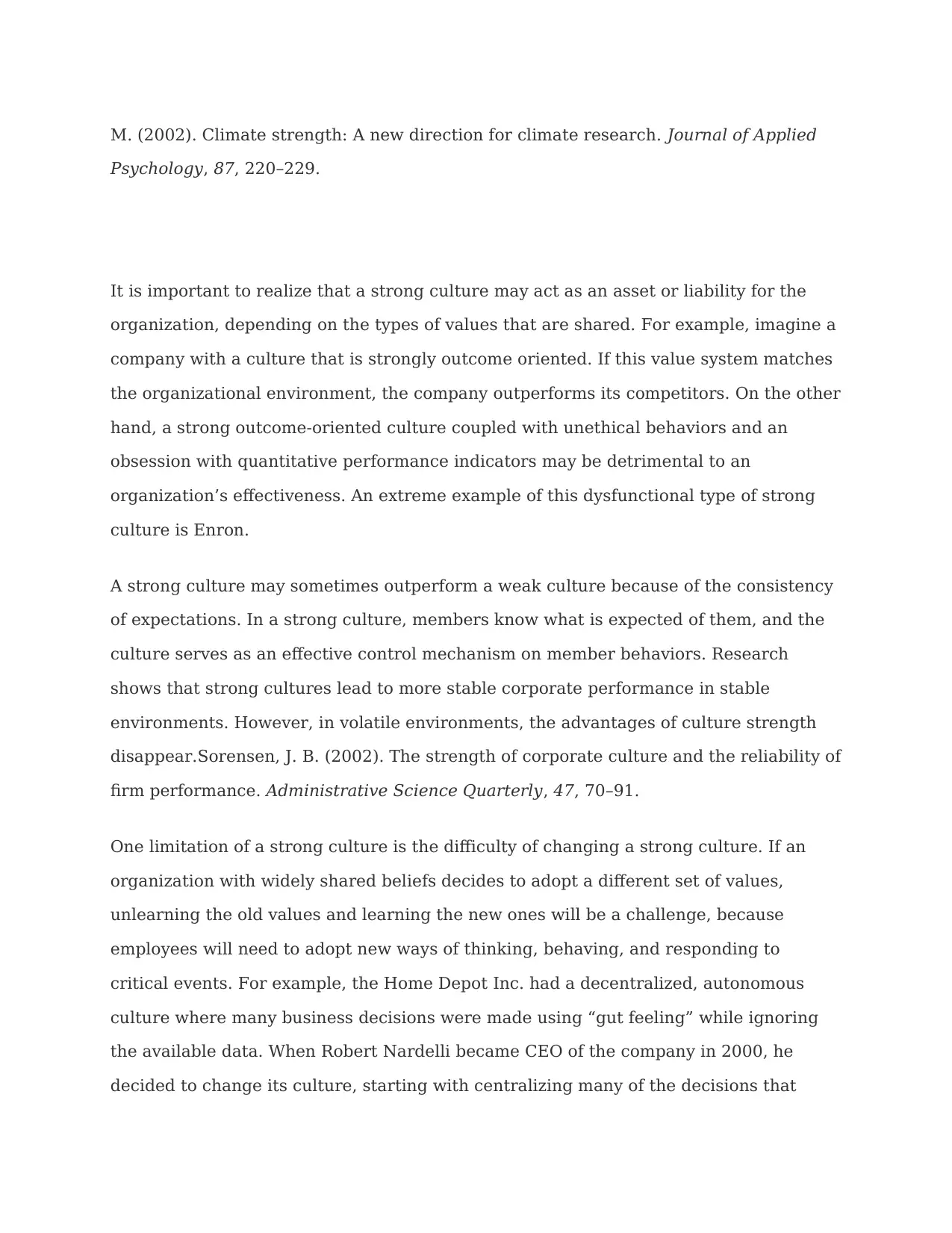
M. (2002). Climate strength: A new direction for climate research. Journal of Applied
Psychology, 87, 220–229.
It is important to realize that a strong culture may act as an asset or liability for the
organization, depending on the types of values that are shared. For example, imagine a
company with a culture that is strongly outcome oriented. If this value system matches
the organizational environment, the company outperforms its competitors. On the other
hand, a strong outcome-oriented culture coupled with unethical behaviors and an
obsession with quantitative performance indicators may be detrimental to an
organization’s effectiveness. An extreme example of this dysfunctional type of strong
culture is Enron.
A strong culture may sometimes outperform a weak culture because of the consistency
of expectations. In a strong culture, members know what is expected of them, and the
culture serves as an effective control mechanism on member behaviors. Research
shows that strong cultures lead to more stable corporate performance in stable
environments. However, in volatile environments, the advantages of culture strength
disappear.Sorensen, J. B. (2002). The strength of corporate culture and the reliability of
firm performance. Administrative Science Quarterly, 47, 70–91.
One limitation of a strong culture is the difficulty of changing a strong culture. If an
organization with widely shared beliefs decides to adopt a different set of values,
unlearning the old values and learning the new ones will be a challenge, because
employees will need to adopt new ways of thinking, behaving, and responding to
critical events. For example, the Home Depot Inc. had a decentralized, autonomous
culture where many business decisions were made using “gut feeling” while ignoring
the available data. When Robert Nardelli became CEO of the company in 2000, he
decided to change its culture, starting with centralizing many of the decisions that
Psychology, 87, 220–229.
It is important to realize that a strong culture may act as an asset or liability for the
organization, depending on the types of values that are shared. For example, imagine a
company with a culture that is strongly outcome oriented. If this value system matches
the organizational environment, the company outperforms its competitors. On the other
hand, a strong outcome-oriented culture coupled with unethical behaviors and an
obsession with quantitative performance indicators may be detrimental to an
organization’s effectiveness. An extreme example of this dysfunctional type of strong
culture is Enron.
A strong culture may sometimes outperform a weak culture because of the consistency
of expectations. In a strong culture, members know what is expected of them, and the
culture serves as an effective control mechanism on member behaviors. Research
shows that strong cultures lead to more stable corporate performance in stable
environments. However, in volatile environments, the advantages of culture strength
disappear.Sorensen, J. B. (2002). The strength of corporate culture and the reliability of
firm performance. Administrative Science Quarterly, 47, 70–91.
One limitation of a strong culture is the difficulty of changing a strong culture. If an
organization with widely shared beliefs decides to adopt a different set of values,
unlearning the old values and learning the new ones will be a challenge, because
employees will need to adopt new ways of thinking, behaving, and responding to
critical events. For example, the Home Depot Inc. had a decentralized, autonomous
culture where many business decisions were made using “gut feeling” while ignoring
the available data. When Robert Nardelli became CEO of the company in 2000, he
decided to change its culture, starting with centralizing many of the decisions that

were previously left to individual stores. This initiative met with substantial resistance,
and many high-level employees left during his first year. Despite getting financial
results such as doubling the sales of the company, many of the changes he made were
criticized. He left the company in January 2007.Charan, R. (2006, April). Home Depot’s
blueprint for culture change. Harvard Business Review, 84, 60–70; Herman, J., &
Wernle, B. (2007, August 13). The book on Bob Nardelli: Driven,
demanding. Automotive News, 81, 42.
A strong culture may also be a liability during a merger. During mergers and
acquisitions, companies inevitably experience a clash of cultures, as well as a clash of
structures and operating systems. Culture clash becomes more problematic if both
parties have unique and strong cultures. For example, during the merger of Daimler
AG with Chrysler Motors LLC to create DaimlerChrysler AG, the differing strong
cultures of each company acted as a barrier to effective integration. Daimler had a
strong engineering culture that was more hierarchical and emphasized routinely
working long hours. Daimler employees were used to being part of an elite
organization, evidenced by flying first class on all business trips. On the other hand,
Chrysler had a sales culture where employees and managers were used to autonomy,
working shorter hours, and adhering to budget limits that meant only the elite flew first
class. The different ways of thinking and behaving in these two companies introduced a
number of unanticipated problems during the integration process.Badrtalei, J., & Bates,
D. L. (2007). Effect of organizational cultures on mergers and acquisitions: The case of
DaimlerChrysler. International Journal of Management, 24, 303–317; Bower, J. L.
(2001). Not all M&As are alike—and that matters. Harvard Business Review, 79, 92–
101. Differences in culture may be part of the reason that, in the end, the merger didn’t
work out.
Do Organizations Have a Single Culture?
and many high-level employees left during his first year. Despite getting financial
results such as doubling the sales of the company, many of the changes he made were
criticized. He left the company in January 2007.Charan, R. (2006, April). Home Depot’s
blueprint for culture change. Harvard Business Review, 84, 60–70; Herman, J., &
Wernle, B. (2007, August 13). The book on Bob Nardelli: Driven,
demanding. Automotive News, 81, 42.
A strong culture may also be a liability during a merger. During mergers and
acquisitions, companies inevitably experience a clash of cultures, as well as a clash of
structures and operating systems. Culture clash becomes more problematic if both
parties have unique and strong cultures. For example, during the merger of Daimler
AG with Chrysler Motors LLC to create DaimlerChrysler AG, the differing strong
cultures of each company acted as a barrier to effective integration. Daimler had a
strong engineering culture that was more hierarchical and emphasized routinely
working long hours. Daimler employees were used to being part of an elite
organization, evidenced by flying first class on all business trips. On the other hand,
Chrysler had a sales culture where employees and managers were used to autonomy,
working shorter hours, and adhering to budget limits that meant only the elite flew first
class. The different ways of thinking and behaving in these two companies introduced a
number of unanticipated problems during the integration process.Badrtalei, J., & Bates,
D. L. (2007). Effect of organizational cultures on mergers and acquisitions: The case of
DaimlerChrysler. International Journal of Management, 24, 303–317; Bower, J. L.
(2001). Not all M&As are alike—and that matters. Harvard Business Review, 79, 92–
101. Differences in culture may be part of the reason that, in the end, the merger didn’t
work out.
Do Organizations Have a Single Culture?
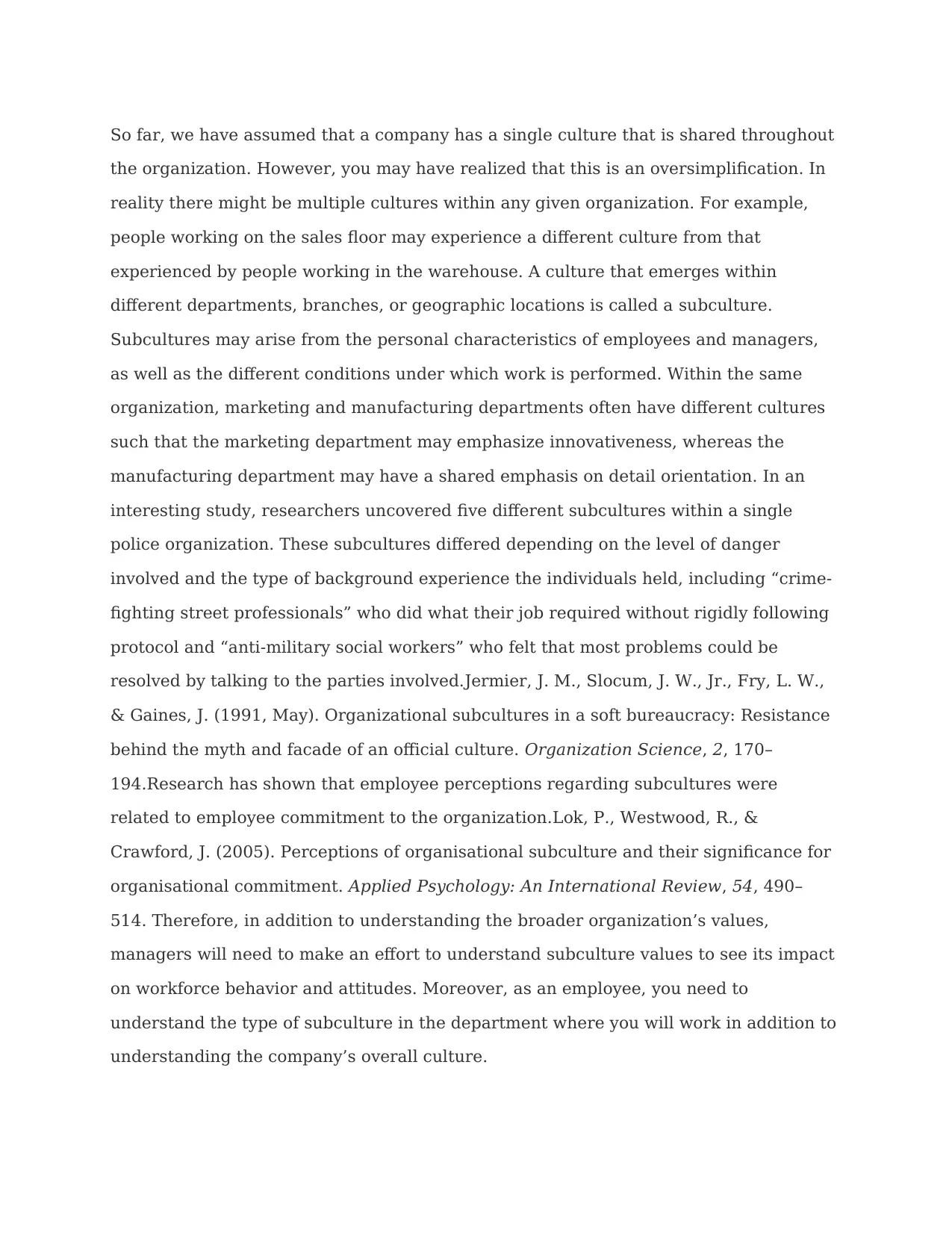
So far, we have assumed that a company has a single culture that is shared throughout
the organization. However, you may have realized that this is an oversimplification. In
reality there might be multiple cultures within any given organization. For example,
people working on the sales floor may experience a different culture from that
experienced by people working in the warehouse. A culture that emerges within
different departments, branches, or geographic locations is called a subculture.
Subcultures may arise from the personal characteristics of employees and managers,
as well as the different conditions under which work is performed. Within the same
organization, marketing and manufacturing departments often have different cultures
such that the marketing department may emphasize innovativeness, whereas the
manufacturing department may have a shared emphasis on detail orientation. In an
interesting study, researchers uncovered five different subcultures within a single
police organization. These subcultures differed depending on the level of danger
involved and the type of background experience the individuals held, including “crime-
fighting street professionals” who did what their job required without rigidly following
protocol and “anti-military social workers” who felt that most problems could be
resolved by talking to the parties involved.Jermier, J. M., Slocum, J. W., Jr., Fry, L. W.,
& Gaines, J. (1991, May). Organizational subcultures in a soft bureaucracy: Resistance
behind the myth and facade of an official culture. Organization Science, 2, 170–
194.Research has shown that employee perceptions regarding subcultures were
related to employee commitment to the organization.Lok, P., Westwood, R., &
Crawford, J. (2005). Perceptions of organisational subculture and their significance for
organisational commitment. Applied Psychology: An International Review, 54, 490–
514. Therefore, in addition to understanding the broader organization’s values,
managers will need to make an effort to understand subculture values to see its impact
on workforce behavior and attitudes. Moreover, as an employee, you need to
understand the type of subculture in the department where you will work in addition to
understanding the company’s overall culture.
the organization. However, you may have realized that this is an oversimplification. In
reality there might be multiple cultures within any given organization. For example,
people working on the sales floor may experience a different culture from that
experienced by people working in the warehouse. A culture that emerges within
different departments, branches, or geographic locations is called a subculture.
Subcultures may arise from the personal characteristics of employees and managers,
as well as the different conditions under which work is performed. Within the same
organization, marketing and manufacturing departments often have different cultures
such that the marketing department may emphasize innovativeness, whereas the
manufacturing department may have a shared emphasis on detail orientation. In an
interesting study, researchers uncovered five different subcultures within a single
police organization. These subcultures differed depending on the level of danger
involved and the type of background experience the individuals held, including “crime-
fighting street professionals” who did what their job required without rigidly following
protocol and “anti-military social workers” who felt that most problems could be
resolved by talking to the parties involved.Jermier, J. M., Slocum, J. W., Jr., Fry, L. W.,
& Gaines, J. (1991, May). Organizational subcultures in a soft bureaucracy: Resistance
behind the myth and facade of an official culture. Organization Science, 2, 170–
194.Research has shown that employee perceptions regarding subcultures were
related to employee commitment to the organization.Lok, P., Westwood, R., &
Crawford, J. (2005). Perceptions of organisational subculture and their significance for
organisational commitment. Applied Psychology: An International Review, 54, 490–
514. Therefore, in addition to understanding the broader organization’s values,
managers will need to make an effort to understand subculture values to see its impact
on workforce behavior and attitudes. Moreover, as an employee, you need to
understand the type of subculture in the department where you will work in addition to
understanding the company’s overall culture.
Paraphrase This Document
Need a fresh take? Get an instant paraphrase of this document with our AI Paraphraser
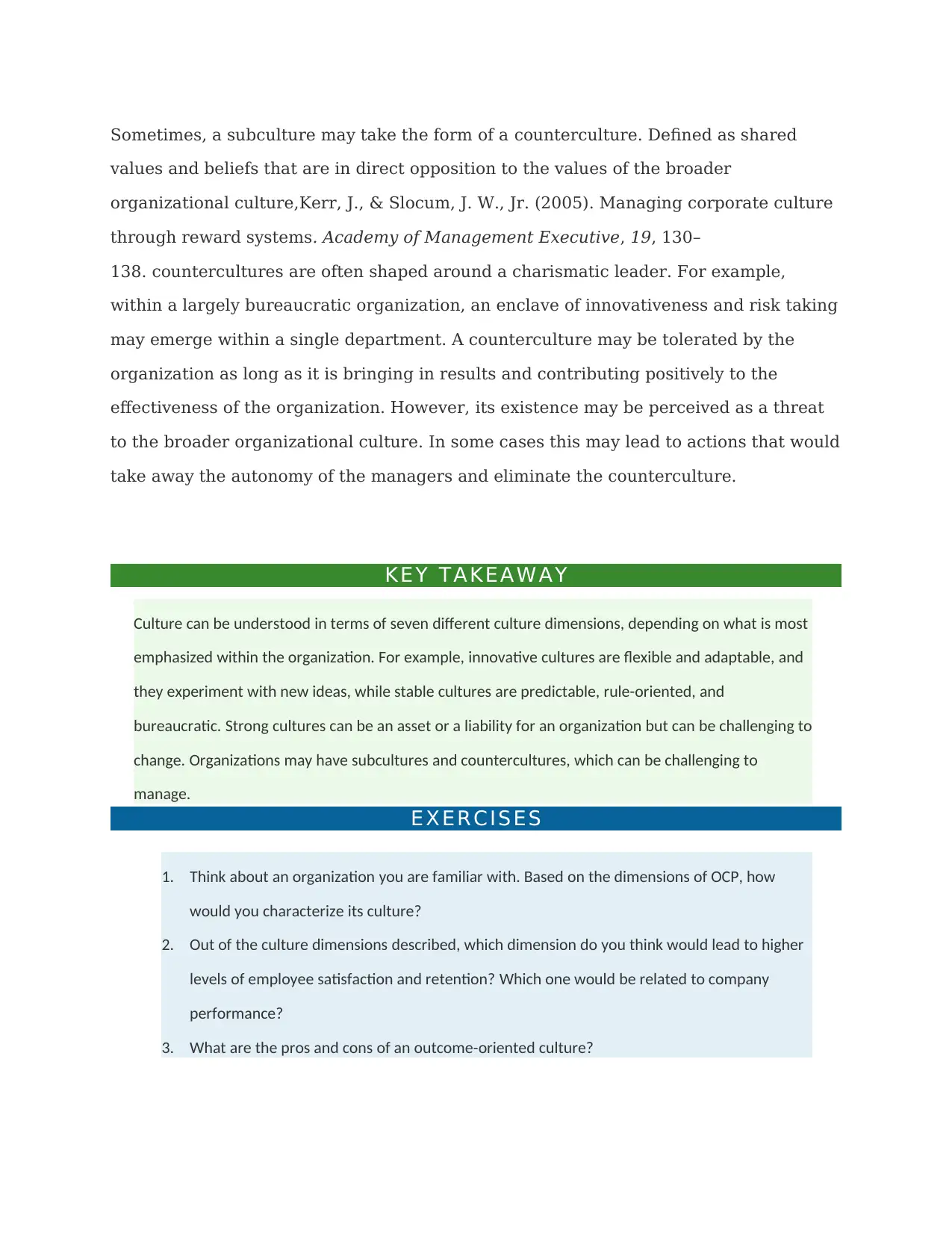
Sometimes, a subculture may take the form of a counterculture. Defined as shared
values and beliefs that are in direct opposition to the values of the broader
organizational culture,Kerr, J., & Slocum, J. W., Jr. (2005). Managing corporate culture
through reward systems. Academy of Management Executive, 19, 130–
138. countercultures are often shaped around a charismatic leader. For example,
within a largely bureaucratic organization, an enclave of innovativeness and risk taking
may emerge within a single department. A counterculture may be tolerated by the
organization as long as it is bringing in results and contributing positively to the
effectiveness of the organization. However, its existence may be perceived as a threat
to the broader organizational culture. In some cases this may lead to actions that would
take away the autonomy of the managers and eliminate the counterculture.
K E Y T A K E A W A Y
Culture can be understood in terms of seven different culture dimensions, depending on what is most
emphasized within the organization. For example, innovative cultures are flexible and adaptable, and
they experiment with new ideas, while stable cultures are predictable, rule-oriented, and
bureaucratic. Strong cultures can be an asset or a liability for an organization but can be challenging to
change. Organizations may have subcultures and countercultures, which can be challenging to
manage.
E X E R C I S E S
1. Think about an organization you are familiar with. Based on the dimensions of OCP, how
would you characterize its culture?
2. Out of the culture dimensions described, which dimension do you think would lead to higher
levels of employee satisfaction and retention? Which one would be related to company
performance?
3. What are the pros and cons of an outcome-oriented culture?
values and beliefs that are in direct opposition to the values of the broader
organizational culture,Kerr, J., & Slocum, J. W., Jr. (2005). Managing corporate culture
through reward systems. Academy of Management Executive, 19, 130–
138. countercultures are often shaped around a charismatic leader. For example,
within a largely bureaucratic organization, an enclave of innovativeness and risk taking
may emerge within a single department. A counterculture may be tolerated by the
organization as long as it is bringing in results and contributing positively to the
effectiveness of the organization. However, its existence may be perceived as a threat
to the broader organizational culture. In some cases this may lead to actions that would
take away the autonomy of the managers and eliminate the counterculture.
K E Y T A K E A W A Y
Culture can be understood in terms of seven different culture dimensions, depending on what is most
emphasized within the organization. For example, innovative cultures are flexible and adaptable, and
they experiment with new ideas, while stable cultures are predictable, rule-oriented, and
bureaucratic. Strong cultures can be an asset or a liability for an organization but can be challenging to
change. Organizations may have subcultures and countercultures, which can be challenging to
manage.
E X E R C I S E S
1. Think about an organization you are familiar with. Based on the dimensions of OCP, how
would you characterize its culture?
2. Out of the culture dimensions described, which dimension do you think would lead to higher
levels of employee satisfaction and retention? Which one would be related to company
performance?
3. What are the pros and cons of an outcome-oriented culture?

4. When bureaucracies were first invented they were considered quite innovative. Do you think
that different cultures are more or less effective at different points in time and in different
industries? Why or why not?
5. Can you imagine an effective use of subcultures within an organization?
that different cultures are more or less effective at different points in time and in different
industries? Why or why not?
5. Can you imagine an effective use of subcultures within an organization?
1 out of 15
Your All-in-One AI-Powered Toolkit for Academic Success.
+13062052269
info@desklib.com
Available 24*7 on WhatsApp / Email
![[object Object]](/_next/static/media/star-bottom.7253800d.svg)
Unlock your academic potential
© 2024 | Zucol Services PVT LTD | All rights reserved.